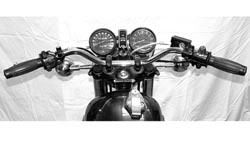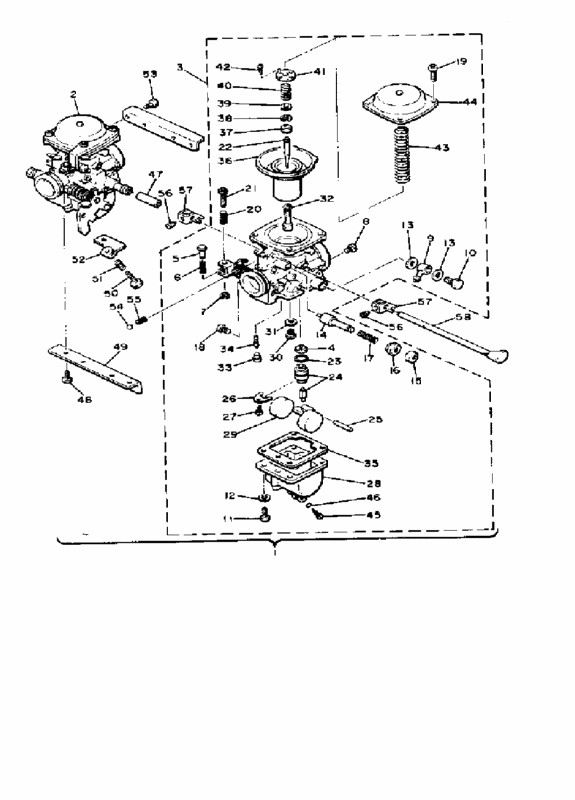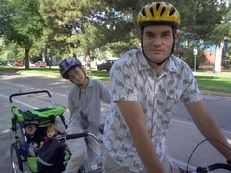Running woe #3: anemic idle requiring blipping throttle
I still had the annoying problem of the idle slowing down. When I'd close the throttle, the idle would immediately drop to about 1200 RPM, but as I sat at stoplights, the idle would get lower and lower until the bike stalled out after about 10 seconds, if I didn't continually blip the throttle. Turning up the idle adjuster screw, even just a quarter turn, would cause the engine to idle about about 3500 RPM.
I thought this idling behavior might be typical of small motorcycles. My sketchy old Seca idled in much the same way. However, when I took the ABATE Experienced Rider course on the provided little Honda Nighthawk 250s, I was stunned that they idled so well. Sitting on the little Nighthawks felt like sitting on a little happy sewing machine that would happily hum along all day at idle.
Then I rode my brother-in-law's 1968 Honda CB450 twin. It too idled like a little sewing machine. Also it's european-style handle bars made me more determined to get rid of my XS400's semi-ape-hanger-custom bars and replace them with something more sporting.
So, I set to work trying to figure out what was wrong with my bike that would force the idle to die a slow death if I didn't blip the throttle.
I thought maybe the issue was a weak spark at idle, which made the engine not run so well, which reduced the RPM, which weakened the spark, etc...causing the engine to eventually stall out. I checked the coils with a multimeter, and they were fine. I had read on The Used Motorcycle Guide about old Yamaha SR500s that would cut out in traffic until the owners replaced their resistance plug boots with non-resistance plug boots. So I ordered new plug wires, non-resistance boots, and a new euro-style handlebar from Mike's XS. The parts, prices, and service was great. The handlebars transformed the bike:

Unfortunately, the idling problem persisted.
So I thought that maybe the pilot jet circuit in the carbs was still clogged with crud, that I wasn't getting sufficient fuel to idle well, and that the only reason I was able to idle is that I had the idle turned up to the verge of the primary fuel circuit...that would certainly explain the touchiness of the idle adjuster screw. So, I tore the carbs apart again, pulled the pilot jets (Size 42.5 Type BS30/96). Although the brass looked a little corroded, none of the passages were blocked. The ends of the jets near the screw driver slots were a little chewed up, but nothing too bad...I think I'll order a new set in case I ever get around to tearing the carbs down again. I cleaned up the jets, reassembled everything, but alas, I still had the same anemic idle.
Then I had a revalation...CV carbs have a spring that pushes down a slide in the carb body (part # 43 in the diagram below).

If that spring was exerting too much pressure on the slide, then the slide would close like a butterfly whenever there wasn't a lot of vacuum above the diaphram. This would cause the idle to drop slowly as the slide was forced closed by the spring until the bike died. The sensitivity on the idle set screw could be caused because the idle was set so it was on the verge of moving the slides up, and setting it even a tiny bit higher would cause the bike to rev up to the butterfly setting (vs. the forced-closed slides' setting which was limiting the idle speed)
Luckily the bike came with a set of extra, gummed-up parts carburetors...
This weekend, I pulled the slide return springs from my bike, and they were about twice as long as the slide return springs from the parts carbs! I put the shorter springs into the working carbs on the bike, and it ran beautifully! I let it sit there idling happily for ten minutes! I revved it up, and it always quickly returned to its happy and consistent idle.
Unfortunately, I didn't have a chance to go for a ride to see how it really ran...but I have high hopes!
I thought this idling behavior might be typical of small motorcycles. My sketchy old Seca idled in much the same way. However, when I took the ABATE Experienced Rider course on the provided little Honda Nighthawk 250s, I was stunned that they idled so well. Sitting on the little Nighthawks felt like sitting on a little happy sewing machine that would happily hum along all day at idle.
Then I rode my brother-in-law's 1968 Honda CB450 twin. It too idled like a little sewing machine. Also it's european-style handle bars made me more determined to get rid of my XS400's semi-ape-hanger-custom bars and replace them with something more sporting.
So, I set to work trying to figure out what was wrong with my bike that would force the idle to die a slow death if I didn't blip the throttle.
I thought maybe the issue was a weak spark at idle, which made the engine not run so well, which reduced the RPM, which weakened the spark, etc...causing the engine to eventually stall out. I checked the coils with a multimeter, and they were fine. I had read on The Used Motorcycle Guide about old Yamaha SR500s that would cut out in traffic until the owners replaced their resistance plug boots with non-resistance plug boots. So I ordered new plug wires, non-resistance boots, and a new euro-style handlebar from Mike's XS. The parts, prices, and service was great. The handlebars transformed the bike:

Unfortunately, the idling problem persisted.
So I thought that maybe the pilot jet circuit in the carbs was still clogged with crud, that I wasn't getting sufficient fuel to idle well, and that the only reason I was able to idle is that I had the idle turned up to the verge of the primary fuel circuit...that would certainly explain the touchiness of the idle adjuster screw. So, I tore the carbs apart again, pulled the pilot jets (Size 42.5 Type BS30/96). Although the brass looked a little corroded, none of the passages were blocked. The ends of the jets near the screw driver slots were a little chewed up, but nothing too bad...I think I'll order a new set in case I ever get around to tearing the carbs down again. I cleaned up the jets, reassembled everything, but alas, I still had the same anemic idle.
Then I had a revalation...CV carbs have a spring that pushes down a slide in the carb body (part # 43 in the diagram below).

If that spring was exerting too much pressure on the slide, then the slide would close like a butterfly whenever there wasn't a lot of vacuum above the diaphram. This would cause the idle to drop slowly as the slide was forced closed by the spring until the bike died. The sensitivity on the idle set screw could be caused because the idle was set so it was on the verge of moving the slides up, and setting it even a tiny bit higher would cause the bike to rev up to the butterfly setting (vs. the forced-closed slides' setting which was limiting the idle speed)
Luckily the bike came with a set of extra, gummed-up parts carburetors...
This weekend, I pulled the slide return springs from my bike, and they were about twice as long as the slide return springs from the parts carbs! I put the shorter springs into the working carbs on the bike, and it ran beautifully! I let it sit there idling happily for ten minutes! I revved it up, and it always quickly returned to its happy and consistent idle.
Unfortunately, I didn't have a chance to go for a ride to see how it really ran...but I have high hopes!

